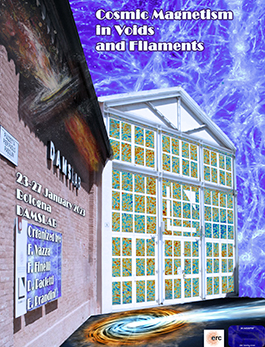Speaker
Description
Faraday rotation studies of distant radio sources can constrain the evolution and the origin of cosmic magnetism. We use data from the LOFAR Two-Metre Sky Survey: Data Release 2 (LoTSS DR2) to study the dependence of the Faraday rotation measure (RM) on redshift. By focusing on radio sources that are close in terms of their projection on the sky, but physically unrelated (‘random pairs’), we measure the RM difference, ΔRM, between the two sources. Thus, we isolate the extragalactic contribution to ΔRM from other contributions. We present a statistical analysis of the resulting sample of random pairs and find a median absolute RM difference | ΔRM | = (1.79 ±0.09) rad m ^−2 , with | ΔRM | uncorrelated both with respect to the redshift difference of the pair and the redshift of the nearer source, and a median excess of random pairs over physical pairs of (1.65 ±0.10) rad m ^−2 . We seek to reproduce this result with Monte Carlo simulations assuming a non-vanishing seed cosmological magnetic field and a redshift evolution of the comoving magnetic field strength that varies as (1 + z) ^−γ. We find the best-fitting results B_0 ≡B_comoving ( z = 0) ≲ (2.0 ±0.2) nG and γ ≲ 4.5 ±0.2 that we conservatively quote as upper limits due to an unmodelled but non-vanishing contribution of local environments to the RM difference. A comparison with cosmological simulations shows our results to be incompatible with primordial magnetogenesis scenarios with uniform seed fields of order nG.

